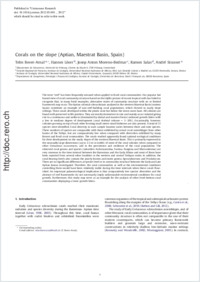Corals on the slope (Aptian, Maestrat Basin, Spain)
- Bover-Arnal, Telm Département de Géosciences, Université de Fribourg, Switzerland
- Löser, Hannes Estación Regional del Noroeste, Instituto de Geología, Universidad Nacional Autónoma de México, Mexico
- Moreno-Bedmar, Josep A. Instituto de Geología, Universidad Nacional Autónoma de México, Mexico
- Salas, Ramon Departament de Geoquímica, Petrologia i Prospecció Geològica, Facultat de Geologia, Universitat de Barcelona, Spain
- Strasser, André Département de Géosciences, Université de Fribourg, Switzerland
-
05.04.2012
Published in:
- Cretaceous Research. - 2012, vol. 37, p. 43-64
English
The term “reef” has been frequently misused when applied to fossil coral communities. Our popular but biased view of coral community structure based on the idyllic picture of recent tropical reefs has failed to recognize that, in many fossil examples, alternative states of community structure with no or limited framework may occur. The Aptian colonial scleractinians analysed in the western Maestrat Basin (eastern Spain) constitute an example of non-reef-building coral populations, which thrived in marly slope settings. These corals developed within the photic zone but below the storm wave-base. All colonies are found well-preserved in life position. They are mostly decimetres in size and mainly occur isolated giving rise to a continuous and uniform (dominated by domal and massive forms) unbound growth fabric with a low to medium degree of development (coral skeletal volume = 5–20%). Occasionally, however, colonies growing on top of each other forming small metre-sized bioherms are also present. A total of 21 species were identified. Coral diversity in each sample location varies between three and nine species. These numbers of species are comparable with those exhibited by coeval coral assemblages from other basins of the Tethys, but are comparatively low when compared with diversities exhibited by many Recent and fossil coral communities. The corals studied apparently found optimal ecological conditions for their development on the marly slopes of the western Maestrat Basin. This is primarily expressed in the unusually large dimensions (up to 2.3 m in width) of some of the coral colonies when compared to other Cretaceous occurrences, and in the persistence and resilience of the coral populations. The observed coral genera and species (suborders Archeocaeniina, Faviina, Fungiina and Microsolenina) are very common in the time interval between the Barremian and the Early Albian and most of them have been reported from several other localities in the western and central Tethyan realm. In addition, the coral-bearing levels also contain the poorly known and exotic genera Agrostyliastraea and Procladocora. There are no significant differences at species level or in community structure between the Early and Late Aptian faunas investigated. Therefore, the coral communities as well as the environmental conditions controlling them would have been relatively stable during the time intervals when these corals flourished. An important palaeoecological implication is that comparatively low species diversities and the absence of reef frameworks do not necessarily imply unfavourable environmental conditions for coral growth. Furthermore, this study may serve as an example for the analysis of other level-bottom coral communities displaying a loose growth fabric.
- Faculty
- Faculté des sciences et de médecine
- Department
- Département de Géosciences
- Language
-
- English
- Classification
- Palaeontology
- License
- License undefined
- Identifiers
-
- RERO DOC 29115
- DOI 10.1016/j.cretres.2012.03.001
- Persistent URL
- https://folia.unifr.ch/unifr/documents/302345
Statistics
Document views: 112
File downloads:
- stra_cos.pdf: 228
